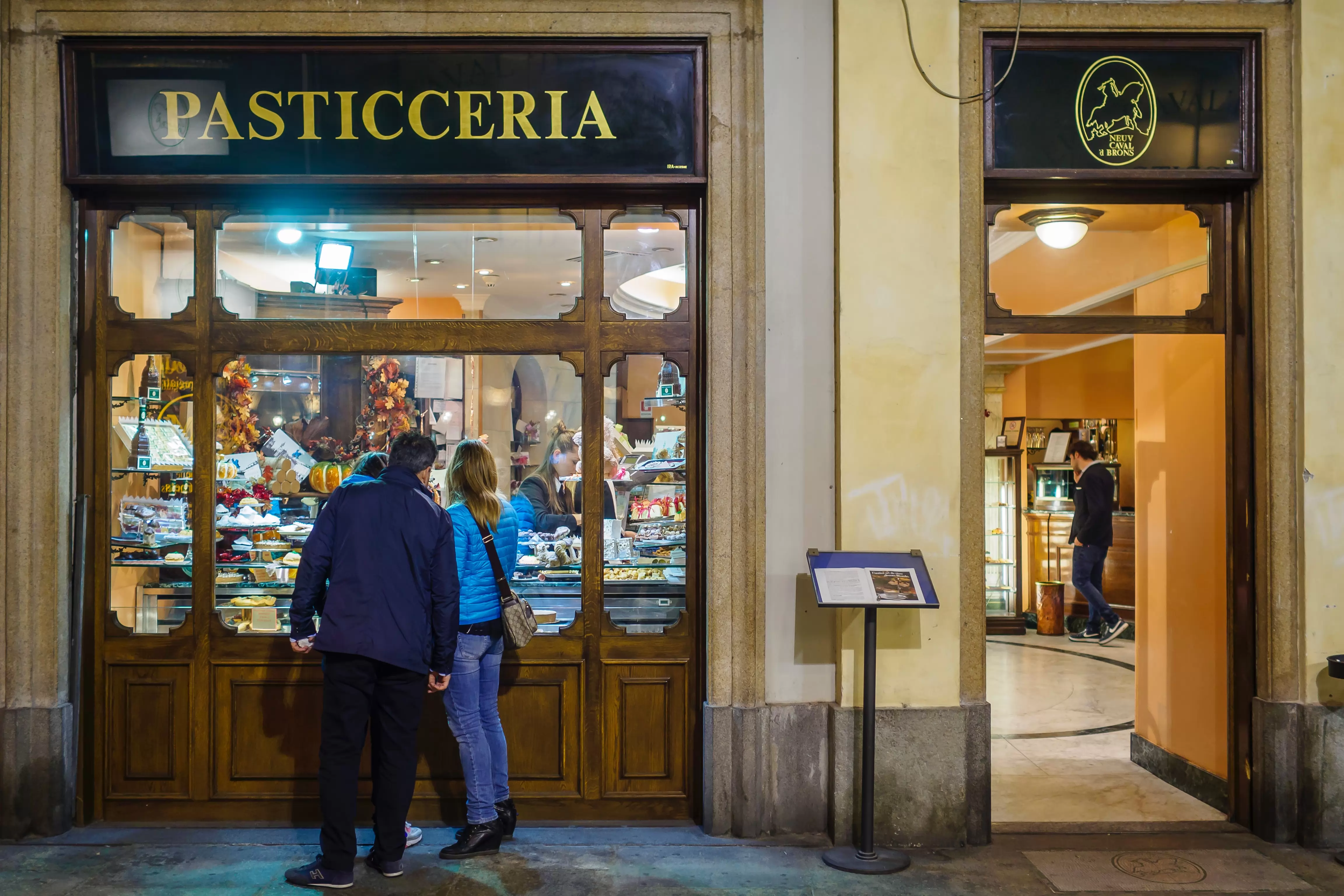Detailed content of our market study
 Inforamtion
Inforamtion
- Number of pages : 35 pages
- Format : Digital and PDF versions
- Last update :
 Summary and extracts
Summary and extracts
1 Market Overview
1.1 Definition and presentation
A bakery is a store that specializes in the production and sale of bread and other savory baked goods, such as flatbreads, breadsticks, pizzas, and cookies. Usually, the bakery focuses more on flour, yeast and water-based products, offering varieties of bread (whole wheat, white, cereal, etc.) and similar products. A bakery, on the other hand, is a store dedicated to the production and sale of sweets, such as cakes, pastries, croissants, cookies, chocolates, and other sugary treats. Patisseries often include more elaborate creations such as special occasion desserts, traditional sweets, and typical regional products.
The value of the global bakery and confectionery market shows steady growth, increasing from $960.09 billion in 2024 to $1346.56 billion in 2030, with an overall increase of 40.3 percent over the period at a compound annual growth rate (CAGR) of 5.80 percent. The growth observed during the historical period is attributed to health-oriented offerings, artisanal and handmade desserts, the fusion of global flavors, functional ingredients, and interactive and experiential products.In 2023, Germany is positioned as the world's largest exporter of bakery and flour products, and the U.S. as the largest importer.
The European bakery market is expected to grow steadily, increasing by 21.2 percent between 2024 and 2030, from $246.71 billion to $298.96 billion at a CAGR of 3.2 percent.The European confectionerymarket shows significant growth of 31% between 2024 and 2030, increasing from $69.40 billion to $90.90 billion at a CAGR of 4.60%.Europe is one of the largest markets for bakery products. In Europe, bread and cookies are the most frequently consumed baked goods; however, demand for other baked goods, including cakes, cookies, pastries, sandwich slices, frozen bread, desserts, flour, and pastries, is growing.
In recent yearsthe turnover of Italian bakery and flour companies has grown by 21.3 percent, while the value of production sold has increased by 24.7 percent.Italy is a significant player globally, being the third largest exporter of bakery and farinaceous products with $4.09 billion in 2023, surpassed only by Germany and Canada. Italian demand is driven by a strong link to tradition, with a high preference for fresh artisanal products (84.9% of the bread market), but emerging trends toward healthy, sustainable, and customizable products are observed. Freshness, quality and craftsmanship are the main drivers, accompanied by growing demands for gluten-free, organic and high-protein options.
1.2 The global market
The value of the global bakery and confectionery market shows steady growth, increasing from $***.** billion in **** to $****.** billion in ****, with an overall increase of **.* percent over the period at a compound annual growth rate (***) of *.** percent. The growth observed during the historical period is attributed to health-oriented offerings, artisanal and handmade desserts, the fusion of global flavors, functional ingredients, and interactive and experiential products.
Global bakery and confectionery market value World, ****-****, in US$ billion ResearchAndMarkets
The global population is increasing and is expected to reach ** billion by ****. This population growth generates an increasing demand for food, necessitating an expansion in the supply of materials used in baking and pastry, as well as an increase in trade volumes. As a result, companies operating in this market are expected to profit from the growing demand for bakery and pastry products due to population expansion over the forecast period. The growing popularity of in-house bakeries in supermarkets is seen as a driving force behind the growth of the bakery and pastry market. In-house bakeries, dedicated sections or departments within grocery stores, produce and sell baked goods on site, such as breads, pastries, cakes, and other baked goods. The convenience, variety, and quality offered ...
1.3 The European market
The European baked goods market is expected to grow steadily, increasing by **.* percent between **** and ****, from $***.** billion to $***.** billion at a CAGR of *.* percent.
Value of the European baked goods market Europe, ****-****, in US$ billion Industryarc
Europe is one of the largest markets for bakery products. In Europe, bread and cookies are the most frequently consumed baked goods; however, demand for other baked goods, including cakes, cookies, pastries, sandwich slices, frozen bread, desserts, flour, and pastries, is growing. The European baking market is being driven by a number of trends, including gluten-free, whole grain, ancient, and additive-free baked goods. In addition, factors such as increased demand for ready-to-eat and convenient products, the availability of low-cost nutritional baked goods, and the variety of bakery product textures and flavor profiles are fueling the growth of the European bakery industry.
The European confectionery market shows significant growth of **% between **** and ****, increasing from $**.** billion to $**.** billion at a CAGR of *.**%. Value of the European confectionery market Europe, ****-****, in US$ billion ResearchAndMarkets
1.4 The Italian market
Between **** and ****, revenues of Italian bakery and flour companies grew by **.* percent, from **.** billion to **.** billion. After a slight decline in **** related to the pandemic, revenues showed a significant recovery, peaking at **.** billion in ****, followed by a slight contraction in ****. The overall trend shows sustained growth, despite fluctuations.
Turnover of bakery and flour manufacturing companies [***] Italy, ****-****, in billion € Istat
Analyzing the fresh bread and pastry production segment, turnover followed a similar trend. After a decline in ****, it grew to *.** billion in ****, with a slight decrease expected in ****. The overall increase from **** to **** is ** percent, confirming the industry's positive trend, albeit with slightly different dynamics than the overall bakery industry.
Turnover of companies active in the production of bread, fresh bakery products [***] Italy, ****-*****, € billion Istat
The value of production sold of bakery and pastry products in Italy increased by **.* percent between **** and ****, from €*.** billion to €*.** billion. After a steady increase until ****, there was a contraction in ****, but this was followed by a significant recovery in ****, which is the highest level in the period under consideration. The overall trend shows non-linear but positive growth.
Value of production sold of bakery and confectionery products Italy, ****-****, in billion € Istat
The categories present ...
1.5 Imports and Exports
Between **** and ****, Italian exports of bakery and flour products increased by **.* percent, from $*.** billion to $*.** billion, while imports grew by **.* percent, from $*.*** billion to $*.** billion. The coverage rate has shown a variable trend, reaching a high of *.** in **** and then stabilizing at *.** in ****, showing a consistently positive trade balance, but with a slight decrease in the difference between exports and imports in recent years.
Imports, exports and coverage rate of bakery and flour products (***) Italy, ****-****, in US$ billion UNComtrade
In ****, France was the main destination market for Italian exports of bakery and farinaceous products, with a **.* percent share, followed by Germany (***). The United Kingdom and Spain together account for **.* percent, while the remaining countries, including Switzerland, Poland and the Netherlands, have lower shares, with a significant **.* percent distributed among other destinations. This shows a strong geographic diversification of exports, with a more pronounced concentration toward European markets. Main destination countries for exports of bakery and flour products Italy, ****, in % UNComtrade
In ****, Germany was the main supplier of bakery and farinaceous products to Italy, with a ** percent share, followed by France (***). Spain, Belgium and Poland together contributed **.* percent, while the remaining countries, including the Netherlands and Slovenia, accounted for smaller shares, ...
1.6 Inflation suffered by the sector
In recent years, the bakery and pastry market has faced major challenges related to inflation, which has hit the entire supply chain hard, from production to sales. Rising raw material costs were one of the first signs of this economic pressure. Key ingredients such as flour, sugar, butter, and cocoa saw significant price increases, often linked to global factors such as the conflict in Ukraine or weather crises that affected harvests. This has made production more expensive for both small artisanal workshops and large industrial companies. Another crucial element has been rising energy costs. Energy is an essential component for bakeries and pastry shops, which use ovens and machinery that are often in operation for many hours a day. Rising utility bills have inevitably affected profit margins, creating additional difficulties for those in the industry. Added to this are higher transportation costs, which have increased the price of raw materials and finished products, further complicating business operations. Faced with these difficulties, the market has reacted in several ways. First, many producers decided to raise prices, passing on some of the increased costs to consumers. However, aware of the price sensitivity of much of the customer base, some have opted for less ...
2 Demand analysis
2.1 Overview of demand
From **** to ****, the average monthly expenditure of Italian households on bread and cereals increased by *.* percent, from €**.** to €**.**. After a stable trend between **** and ****, with minimal changes, there is a decrease in **** (***) followed by a sharp increase in ****. This increase could reflect the impact of inflation or other economic factors on the purchase of these products.
Average monthly household expenditure item for bread and cereals [***] Italy, ****-****, in current &euro Istat
Between **** and ****, Italian production of bakery and flour products increased by **.* percent, from *.** to *.** million tons. After a peak in **** with *.** million, probably related to an increase in demand during the pandemic, there is a decline in **** and a subsequent recovery until ****, with a return almost to **** levels. The trend shows overall growth despite intermediate fluctuations. Production realized in quantity of bakery and flour products [***] Italy, ****-****, in millions of tons Istat
From **** to ****, the quantity of bakery and farinaceous products sold in Italy increased by **.* percent, from *.** to *.** million tons. After peaking in **** with *.** million, sales declined until ****, reaching a low of *.** million, before recovering in ****. The gap between production made and sold has increased in recent years, indicating a possible increase in inventories or a shift toward exports. Production ...
2.2 Geographical distribution of demand
Average monthly household spending on bread and cereals shows rather similar values among different areas of Italy, with the Northeast leading the ranking with **.** €, followed by the Islands (***) is about *.* percent, indicating some homogeneity in spending habits, albeit with some slight regional variations.
2.3 Demand drivers
The bread and pastry market is facing a time of evolution in response to emerging trends and consumer preferences. The market for artisanal fresh bread production remains very popular in Italy, covering about**.* percent of the market. Average production stands slightly below * million units.[***]
For **** and ****, forecasts indicate growth in the Italian food market, with rates around * percent annually, although these figures could have changes caused by inflation affecting Europe. Specifically, in Italy, the flour and coffee sectors will achieve the best performance.[***]
Performance analysis - growth of (***) compartments Italy, ****, % Sweet Savory
Bread and baked goods are booming in Italy as more and more people turn to their local bakery or supermarket instead of baking at home. Italy's milling industry processes *,***,*** tons of soft wheat annually, which enables the production of about *,***,*** tons of flour, ** percent of which is used for the production of breads (***), and ** percent for the production of pizza, confectionery or pastry products. Annual per capita consumption is around ** kg in Italy.[***]
According to the latest survey conducted by Italmopa,**% of Italians surveyed habitually consume bread and its derivatives, while **% of respondents say they do not consume it or consume it occasionally. The main reason for excluding bread ...
2.4 Trend in demand
Online bakery searches in Italy between **** and early **** show strong seasonality, with peaks in the summer months and December. In ****, the index rises from ** in January to a high of **.* in August, followed by another peak in December (***), showing consistent behavior during the periods of greatest interest.
Trend of online bakery searches Italy, ****-****, index Google Trends, Businesscoot elaboration
Online searches related to bakery are mainly concentrated in Piedmont, with a score of ***, followed by Valle d'Aosta (***) is ** percent. This suggests a concentration of interest in baking in the northern regions and gradually less interest in other parts of Italy.
Online searches for bakeries in Italy between **** and early **** show a similar trend to that of bakeries, with clear seasonal peaks. In ****, the index rises from **.* in January to a high of **.* in December, while the summer months see an increase to **.* in August. In ****, the trend is similar, with a peak of **.* in December and a summer increase to **.* in August. The beginning of **** (***) confirms a typical post-Christmas decline, with marked seasonality related to holidays and summer tourism.
Trend of online searches for bakeries Italy, ****-****, index Google Trends, Businescoot elaboration
Online searches related to pastry shops are particularly concentrated ...
2.5 New trends in demand
he bakery and pastry market is evolving dynamically, responding to new consumer demands for healthier, more sustainable and personalized products, but also through technological and digital innovations. Successful producers are those who manage to combine tradition and innovation, adapting quickly to market changes and emerging trends.
*. Increasing demand for healthy and functional products:
Consumers are becoming increasingly health and wellness conscious, and this trend is also reflected in their choice of breads and pastries. Demand for products with functional ingredients, such as whole-grain, gluten-free, no-added-sugar, organic, and fiber-rich flours, is growing rapidly. In particular:
Gluten-free bread: An increasing number of people suffer from celiac disease or follow gluten-free diets for health reasons. Manufacturers are responding to this demand with a wide range of options, ranging from breads to cakes, made with alternative flours such as rice, corn, sorghum, or quinoa. Alternative sugars: The use of natural sweeteners such as stevia, honey, or fruit syrups is gaining popularity, along with reducing the use of refined sugars in baked goods. Protein breads: As awareness increases regarding the importance of protein in the diet, some bakeries are introducing high-protein breads, enriched with ingredients such as chia seeds, legumes, or flours with high nutritional ...
3 Market structure
3.1 Market structure and dynamics
Between **** and ****, the number of enterprises active in the production of bakery and flour products in Italy decreased by **.* percent, from **,*** to **,***. The decline has been steady, with a significant average annual reduction, reflecting possible industry concentration or economic difficulties for smaller firms. The trend suggests a gradual rationalization of the market.
Number of enterprises active in the production of bakery and flour products [***] Italy, ****-****, in number Istat
In ****, the majority of businesses active in the production of bakery and flour products in Italy are sole proprietors, freelancers, and self-employed, accounting for **.* percent of the total. This is followed by general partnerships (***), have a much smaller weight. This scenario shows a predominance of smaller and more traditional business structures in the sector. Legal form of companies active in the production of bakery and flour products Italy, ****, in % Istat
From **** to ****, the number of people employed in the production of bakery and flour products in Italy decreased by *.* percent, from ***,*** to ***,***. After a steady decline between **** and ****, there was a slight stabilization in **** and ****, followed by a further reduction in ****. This trend reflects a contraction of the industry, linked to a decrease in the number of active enterprises and increasing automation ...
3.2 Value Chain
The value chain and operation of the bakery and pastry market in Italy is presented below.
Origin of raw materials: Farms Raw materials come from farms, which grow cereals for various uses. Grains are harvested and managed through traders and private collection centers, cooperatives, producer associations, and agrarian consortia, which facilitate logistics, initial processing, and distribution. Feed industry A portion of harvested grain is destined for the feed industry to produce feed for the livestock sector. Processing stages: First processing (***) Grains are processed into intermediate products, such as flour and semolina, through the milling industry. This stage represents the first level of processing, which is essential for the subsequent destination of the products. Second processing The intermediate products derived from first processing are further processed in three main sectors: Pastaindustry: Production of pasta, a key sector for the Italian food market. Artisan and industrial bakery: Production of bread and baked goods, intended for direct consumption. Confectionery industry: Production of cakes, cookies and other sweet bakery products, which represent a major part of the food market. Distribution: Final destination of products Export: A significant part of production, particularly pasta and baked goods, is destined for international markets, contributing to the positioning of ...
3.3 Distribution channels
The distribution of bakery and pastry in Italy is divided through different channels, each characterized by specificities related to the nature of the product, target customers and market dynamics.
*. Retail outlets (***)
Independent bakeries and pastry shops: They represent the heart of Italian tradition. These are artisanal businesses that produce bread, pastries and baked goods, sold directly to the end customer. Artisanal quality, freshness and connection with the territory are the strong points. Franchising: Chains such as "Panificio Spiga d'Oro" or "La Bottega del Pane" offer replicable and standardized models, ensuring uniform quality and brand recognition on a national scale.
*. Large-scale retail trade (***)
Supermarkets and hypermarkets: Most chains (***) have in-house bakery and pastry departments or work with local suppliers to offer fresh products. Private Label: Many supermarkets market baked goods and pastries under their own brand, focusing on convenience and acceptable quality. Refrigerated Distribution: Large-scale retailers also rely on long-life packaged products, such as industrial cakes (***) and precooked bread.
*. Horeca (***)
Barsand cafeterias: Important distribution points for pastry products, often supplied by artisan workshops or local companies specializing in fresh or frozen products. Hotels and restaurants: Offer breakfasts and desserts as an integral part of service. Many purchase products from ...
3.4 The main market players - production of bakery and flour products
The following companies are the main ones in the market:
PaneAlba: An Italian company founded in **** in Verduno, in the province of Cuneo, by Mr. Aldo Tesio. Initially a small artisan business, it has transformed over time into one of the most authentic expressions of Made in Italy, recognized not only nationally but also internationally. The company produces more than ** references, including the famous breadsticks, crostini and savory sfogliette, the latter being among the most recent novelties. The goodness of Panealba products comes from a unique processing method, which involves up to ** hours of leavening, and the high genuineness of the selected raw materials.
Morato Pane: An Italian company specializing in the production of baked goods, established in **** in Vicenza by Luigi Morato. Initially operating in a small store, the company started its first industrial productions in ****, introducing iconic lines such as Tenerelle, Bruschelle, Spuntinelle and Nuvolatte. In ****, it launched the American Sandwich, one of the group's best-selling and most representative references. The company is part of the Morato Group, an international company that produces and distributes quality and sustainable baked goods, including brands such as Roberto and Nutrifree. Over the years, Morato Pane has expanded its international presence, acquiring a ...
3.5 The main market players - production of fresh bread and pastry products
The main companies producing fresh bread and pastry products are as follows:
Bontà Lucane: An Italian company based in Matera, Basilicata, specializing in the production of baked goods, particularly cookies and crackers. Founded in ****, the company has more than ** years of experience in the industry, combining tradition and innovation to offer high-quality products. Bontà Lucane's mission is to respect tradition in the age of technology, enhancing the goodness of the Lucanian land. With a young and dynamic management, Bontà Lucane aims to become a major player in the baked snacks sector in Europe. The company regularly participates in international food fairs, such as Anuga and SIAL Paris, to present its novelties and consolidate its presence in the global market.
Baccinello Bakery: a Tuscan artisan company with a long tradition in the production of bread and baked goods. Founded in **** in Baccinello, a hamlet of Grosseto, this bakery has been able to keep the traditional recipes of the Maremma alive, offering genuine products with authentic flavor. From the beginning, the company has stood out for its attention to the quality of its raw materials, selecting local flours and extra virgin olive oil to ensure a product that respects the flavors of yesteryear. ...
4 Supply analysis
4.1 Overview of the offer
A varied and constantly updated supply stimulates further purchases, offsetting the decline in traditionally understood bread and helping to shift sales to more profitable products. Diversification is increasingly practiced and is effective throughout the country, including small towns.
The gap between North and South has narrowed in recent years: bakers in the Central and South are becoming more receptive and responsive to change and are adapting their offerings to attract customers. In the North, bakers aim to include/enhance cafeteria offerings (***) and bakery production, even in the evenings, which favors gourmet take-out.
Pizza and focaccia have slowed the growth recorded in the past two years. Among the main causes, especially in large cities, is the crowding of offerings, often at very competitive prices, as well as the choice of alternative, less caloric meals that are also readily available in supermarkets. Demand for pizza is better in the south, thanks to evening takeout.
On the other hand, pastries are growing steadily.
Supply by region
In Italy it is possible to find a decidedly varied offer depending on the regions that are taken into analysis. Italian bread is considered one of the best in Europe, being a true pillar of Italian cuisine. For ...
4.2 Wheat: The main driver of supply
Soft wheat is the basic raw material for the domestic milling industry, which processes it into flour for bread and other baked goods. The Italian industry's supply depends on domestic production and international supply.
In **** , soft wheat sowings are expected to be about ***,*** hectares in total, an increase of *.* percent, or **,*** hectares more than last year. All areas show positive signs: +*.* percent in the Northwest (***).[***]
Soft wheat flour production in Italy declined steadily between **** and ****, from *.** million tons to *.** million, an overall reduction of ** percent. This decline shows a significant negative trend for the sector over the period.
Wheat flour (***) production Italy, ****-****, in million tons (***) Istat
4.3 Price trends in the market
The consumer price index for other bakery and pastry products in Italy increased from ***.* to ***.* between December **** and December ****, marking a growth of *.* percent. Thereafter, estimated data for **** show a fluctuating but overall slightly increasing trend, with an expected maximum value of ***.* in December ****, suggesting a stabilizing trend with slight fluctuations.
Consumer price index for the entire community of [***] Other bakery and confectionery products (***) - monthly data Italy, ****-****, index Istat
Between **** and ****, the annual average consumer price index for other bakery and pastry products in Italy increased by **.* percent, from ***.* to ***.*. For ****, the estimated value of ***.* indicates a further increase of *.* percent over ****, suggesting a moderate but steady growth trend.
Consumer price index for the whole community of [***] Other bakery and confectionery products (***) - annual averages Italy, ****-****, index Istat
The table below shows the average prices of a one-pound loaf of bread in major Italian cities. As is evident, prices are highly variable, suggesting that bread price trends are only marginally dependent on the cost of wheat, with agricultural commodity prices now less and less linked to real trends in supply and demand.
[***]
The table below shows an overview of average pastry prices in euros/kilo.
[***]
4.4 The best bakeries and pastry shops in Italy
In the wide range of bakeries in Italy, Gambero Rosso has compiled a list of the best bakeries, divided by region, awarded the Tre Pani[***] recognition:
Piedmont: Vulaiga, Fobello (***). Lombardy: Voglia Di Pane, Brescia (***). Veneto: Olivieri ****, Arzignano (***). Trentino Alto Adige: Panificio Moderno, Isera (***). Friuli Venezia Giulia: Jerian, Trieste (***). Emilia Romagna: Forno Brisa, Bologna (***). Tuscany: Pank La Boulangeria, Florence (***). Marche: L' Assalto ai forni, Ascoli Piceno (***). Latium: Panificio Bonci, Rome (***). Campania: La Francesina Boulangerie, Ercolano (***). Puglia: Panificio Adriatico, Bari (***). Basilicata: Pane e pace, Matera (***). Sicily: Panificio Guccione, Palermo (***). Sardinia: PBread Natural Bakery, Cagliari (***).
Gambero Rosso compiled the same list covering the best pastry shops in Italy, awarded the Tre Torte recognition. Below is the list:
Piedmont : Dalmaso (***) Lombardy : Pasticceria Veneto (***) Veneto : Biasetto (***) Trentino-Alto Adige: Acherer Patisserie.Blumen (***) Emilia-Romagna: Gino Fabbri Pasticcere (***) Tuscany : Nuovo Mondo (***) Latium : Bompiani (***) Campania : Maison Manilia (***) Puglia : L'Arte Bianca (***) Sicily : Sciampagna (***)
4.5 New supply trends
New trends in bakery and pastry market offerings reflect changes in consumer tastes, food preferences, and focus on sustainability and innovation.
*. Health and Wellness:
Sugar and fat reduction: There is a growing demand for products with reduced sugar, saturated fat and calorie content without compromising taste. Bakeries and bakeries are introducing "light" desserts and breads enriched with healthy ingredients such as fiber and protein. Gluten- and lactose-free products: The offer is diversifying with products suitable for people with intolerance or allergies. More and more bakeries are specializing in desserts without gluten, lactose or common allergens. Use of alternative flours: Flours such as almond, chickpea, coconut and oat are becoming more popular, valued both for their nutritional properties and distinctive flavor.
*. Innovation and Sustainability:
Eco-friendly packaging: There is a growing focus on using biodegradable, compostable or recyclable packaging to reduce environmental impact. Sustainable ingredients: Many laboratories are introducing raw materials from sustainable and certified supply chains, such as fair-trade cocoa, organic cane sugar, and local flours. Waste reduction: The circular economy is entering the sector with initiatives to reuse waste, such as stale bread turned into cookies or cakes.
*. Customization and Experience:
Customized products: Bakeries offer the possibility to ...
5 Regulations
5.1 Regulation and regulatory framework
The regulation of the bakery and confectionery market in Italy is governed by a series of laws and regulations that ensure compliance with food safety, product quality, and workers' rights. These regulations cover aspects related to the opening and management of businesses, the necessary authorizations, and production and sales methods.
*. Requirements for opening bakeries and pastry shops
In order to start a bakery or pastry shop, it is necessary to comply with Legislative Decree ***/****, known as the "Bersani Reform," which regulates commerce and introduces the requirement to submit the Certified Declaration of Commencement of Activity (***) to the relevant municipality. The SCIA certifies that the activity complies with zoning, building and health regulations.
Another key law is Law No. ***/****, which regulates bread production and sets minimum quality standards. For example, fresh bread must be produced without the use of chemical additives or preservatives.
In addition, artisan business owners must register with the Chamber of Commerce, indicating the appropriate ATECO code, for example, code **.**.** for the production of fresh bakery products.
*. Sanitation regulations
Food safety is mainly regulated by EC Regulation No. ***/****, which establishes general requirements for food hygiene throughout the European Union. Bakeries and pastry shops must implement a self-control ...
5.2 Conclusion
The global, European, and Italian bakery and pastry market shows sustained growth, with an estimated global value of $*** billion in **** and a forecast to reach $***.* billion by ****, thanks to a CAGR of * percent. In Europe, the market will grow by **.*% between **** and ****, while in Italy there is a similar trend with a **.*% increase over the same period. In Italy, the market is highly fragmented, composed mainly of small artisanal companies (***), but is experiencing a slight concentration due to economic difficulties and rationalization of resources, with a **.*% reduction in active companies from **** to ****.
Italy is a significant player globally, being the third largest exporter of bakery and flour products with $*.** billion in ****, surpassed only by Germany and Canada. Italian demand is driven by a strong link to tradition, with a high preference for fresh artisanal products (***), but emerging trends toward healthy, sustainable, and customizable products are observed. Freshness, quality and craftsmanship are the main drivers, accompanied by growing demands for gluten-free, organic and high-protein options.
On the supply side, the sector is characterized by a mix of tradition and innovation. Companies such as Morato Pane, PaneAlba, and Grissitalia have invested in innovative processes and international expansion, while players such as Roberto Alimentare ...
6 Positioning of players
6.1 Market segmentation
- PaneAlba
- Morato Pane
- Grissitalia
- Roberto Industria Alimentare
- Bimbo Qsr
- Dolceria Alba
- Pasticceria Quadrifoglio
- Dolcificio Gi&sse
- Dulcistar
- Zero+4
All our studies are available online in PDF format
Take a look at an example of our research on another market!
 Choosing this study means :
Choosing this study means :
Access to more than 35 hours of work
Our studies are the result of over 35 hours of research and analysis. Using our studies allows you to devote more time and added value to your projects.
Benefit from 6 years' experience and over 1,500 industry reports already produced
Our expertise enables us to produce comprehensive studies in all sectors, including niche and emerging markets.
Our know-how and methodology enable us to produce reports that offer unique value for money.
Access to several thousand articles and paid-for data
Businesscoot has access to all the paid economic press as well as exclusive databases to carry out its market research (over 30,000 articles and private sources).
To enhance our research, our analysts also use web indicators (semrush, trends, etc.) to identify market trends and company strategies. (Consult our paying sources)
Guaranteed support after your purchase
A team dedicated to after-sales service, to guarantee you a high level of satisfaction. +44 238 097 0676
A digital format designed for our users
Not only do you have access to a PDF, but also to a digital version designed for our customers. This version gives you access to sources, data in Excel format and graphics. The content of the study can therefore be easily retrieved and adapted for your specific needs.
 Our offers :
Our offers :
the bakery and pastry market | Italy
- What are the figures on the size and growth of the market?
- What is driving the growth of the market and its evolution?
- What is the positioning of companies in the value chain?
- Data from several dozen databases
5 reports pack (-15%) IT Italy
- 5 reports at €75.6 excluding VAT per study to choose from our Italian catalogue for 12 months
- Save 15% on additional studies purchased
- Choose to be refunded any unused credit at the end of the 12-month period (duration of the pack)
See the terms and conditions of the pack and the refund of unused credit.















